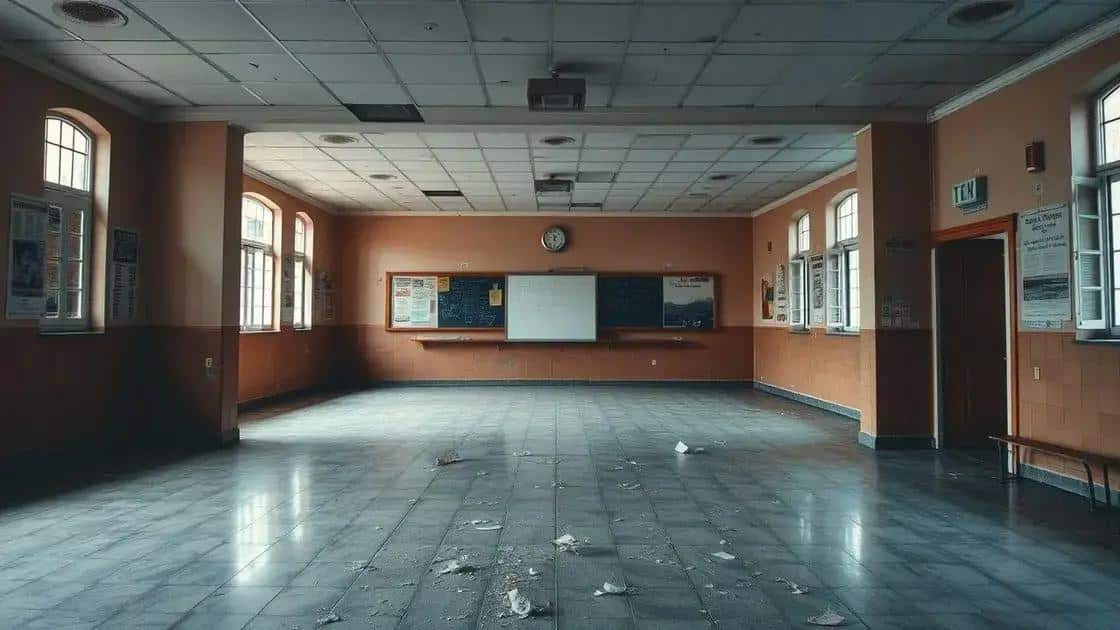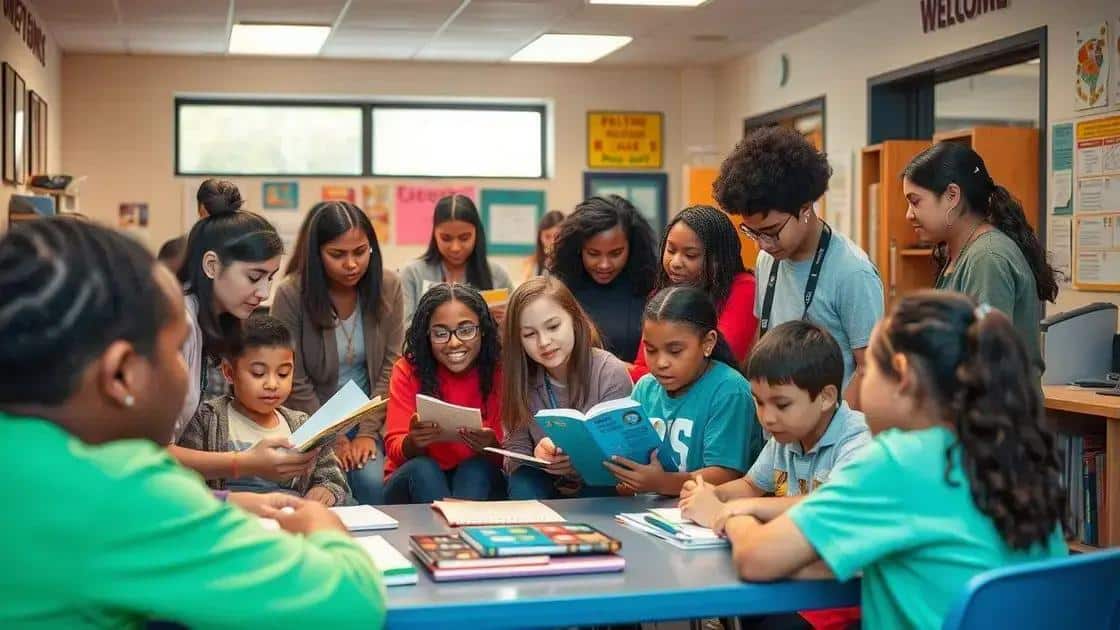Why shuttering the Education Department will harm vulnerable students
Anúncios
Shuttering the Education Department will significantly impact the most vulnerable students by removing essential federal support and resources, leading to increased educational inequality and long-term negative outcomes.
Why shuttering the Education Department can have devastating effects on the most vulnerable students isn’t just a matter of policy. It touches on the education and future of countless children. Let’s explore what this really means.
Understanding the role of the Education Department
The Education Department plays a vital role in shaping how students receive education in the United States. It sets policies and provides funding that ensures children, especially those from vulnerable backgrounds, have access to quality education.
Fundamentally, the department oversees various laws and regulations aimed at promoting educational equity. This means that without these guidelines, many students could face significant barriers to education.
Key Functions of the Education Department
The department is responsible for a range of essential actions that impact schools and students throughout the country:
-
💵 Distributing federal education funding to local schools.
-
📜 Ensuring compliance with educational standards and laws.
-
🔬 Conducting research to identify effective educational practices.
-
🤝 Supporting initiatives that assist low-income families and students with special needs.
Without the department, states may struggle to address the needs of disadvantaged students effectively. They often rely on federal support and resources to fill gaps.
Another significant function of the Education Department is monitoring the implementation of programs aimed at enhancing student performance. Programs like Title I funding are crucial for schools that serve a high percentage of low-income students. The department’s oversight ensures that these schools receive the resources they need.
Challenges Faced in Education
Furthermore, the department also takes on the challenge of addressing educational inequality across different demographics. This involves developing policies that target specific areas of need.
- Advocating for students of color to have equal educational opportunities.
- Promoting access to early childhood education programs.
- Supporting initiatives for students with disabilities.
As we see, the role of the Education Department is complex and multifaceted. Each function interconnects, creating a web of support for students who may otherwise be left behind. As federal backing is pulled away, understanding these roles becomes increasingly crucial.
Immediate consequences of shuttering the department

Shuttering the Education Department will lead to immediate and severe consequences for schools and students across the nation. As federal funding vanishes, educational institutions will struggle to maintain essential programs.
One of the most pressing issues is the loss of financial support for low-income students. Without this funding, schools may face cuts that affect tutoring, after-school programs, and special education services.
Direct Impacts on Schools
Schools that heavily rely on federal funds will find it challenging to operate efficiently without proper resources. This could result in:
- Increased class sizes, limiting personalized attention for students.
- Reduction in extracurricular activities that aid in student development.
- Inability to provide necessary materials like textbooks and technology.
The immediate fallout will disproportionately affect vulnerable student populations. These students often depend on federal support to access even the most basic educational resources.
Effects on State Budgets
Furthermore, states will face budget constraints as they scramble to fill the gap left by the federal government. Many states struggle to allocate sufficient money for education even with federal support. Losing this funding can result in:
- Increased pressure on state budgets, leading to possible tax hikes.
- Potential cuts to other public services as states prioritize education.
- Heightened disparities between wealthy and low-income districts.
The ripple effects of shuttering the Education Department will be felt beyond just the classroom. Families will be forced to navigate a system that becomes less supportive and accessible, which might leave many students behind.
Long-term effects on vulnerable student populations
The long-term effects on vulnerable student populations due to shuttering the Education Department can be profound and far-reaching. These students often face unique challenges, and losing federal support can worsen their situations significantly.
One critical impact is the lack of access to essential resources. Low-income students typically rely on federal programs for food, transportation, and educational materials. Without these supports, many will struggle to succeed in school.
Educational Attainment and Opportunities
Over time, this lack of resources can lead to decreased educational attainment. Many factors contribute to this decline:
- Limited access to technology and learning materials.
- Decreased funding for tutoring and after-school programs.
- Higher drop-out rates due to financial pressures.
As students fall behind in their studies, their opportunities become more limited. This cycle can trap families in poverty, affecting future generations.
Social and Emotional Well-being
Furthermore, many vulnerable students also experience significant social and emotional challenges. The absence of support systems can lead to:
-
😟 Increased stress and anxiety related to academic performance.
-
🚫 Lack of engagement and motivation to learn.
-
🤐 Feelings of isolation due to reduced extracurricular activities.
As these students navigate their educational journeys, they may encounter barriers that others do not face. This heightened adversity can diminish their confidence and aspirations.
The long-term implications extend well beyond education. Reduced educational outcomes can lead to fewer job opportunities, perpetuating the cycle of poverty. Investing in education creates a ripple effect that benefits individuals and society overall.
Exploring alternatives to support affected students

As schools face the imminent loss of the Education Department’s support, exploring alternatives to support affected students becomes urgent. Various strategies can help fill the gaps left behind.
Community involvement plays a crucial role. Local organizations can step in to provide resources and programs to help students succeed. When schools are underfunded, communities must rally together.
Community and Local Initiatives
One way to support students is by creating community partnerships. These collaborations can lead to:
-
📚 Tutoring programs run by local volunteers.
-
🏫 After-school activities funded by businesses.
-
🍲 Food pantries offering meals for low-income families.
Engaging the community not only provides necessary resources but also fosters a sense of belonging for students.
Utilizing Technology
An increasing reliance on technology presents another avenue for supporting students. Remote learning tools and online resources can enhance educational opportunities. Some solutions include:
- Access to free online classes and educational apps.
- Virtual tutoring sessions with trained educators.
- Partnerships with tech companies to provide devices and internet access.
Technology can bridge the gap, making learning more accessible even during challenging times.
Non-profit organizations can also serve as important allies. Many focus on educational equity and provide essential support. These organizations can help create scholarship funds, supply educational materials, and advocate for policy changes that benefit students. Supporting legislation that aims to protect funding for education is also essential for long-term change.
In summary, while shuttering the Education Department poses numerous challenges, there are alternative pathways to ensure students still receive the education they deserve.
In conclusion, shuttering the Education Department poses significant challenges for vulnerable students. Without federal support, schools will struggle, impacting essential resources and educational opportunities. However, through community involvement, technology access, and support from non-profit organizations, we can find alternative ways to aid these students. It’s crucial to advocate for policies that protect education funding, ensuring all students receive a fair chance to succeed. By working together, we can create a more equitable education system for everyone.
FAQ – Frequently Asked Questions about Supporting Affected Students
What can communities do to help vulnerable students?
Communities can engage local organizations and volunteers to provide tutoring, after-school programs, and resources to help students succeed.
How can technology assist in education?
Technology can offer access to online learning tools, virtual tutoring, and educational apps that enhance the learning experience for students.
What role do non-profit organizations play in education?
Non-profits can provide essential support such as scholarships, educational materials, and advocacy for equitable education policies.
Why is it important to advocate for education funding?
Advocating for education funding ensures that all students have access to the resources they need, helping to improve educational equity and opportunities.






